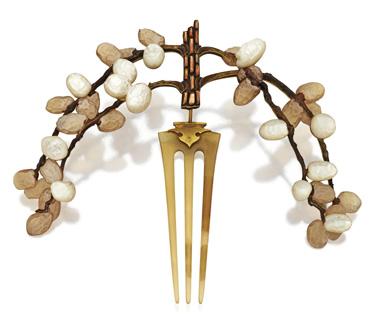Well, sometimes your mind explodes. I would have never thought a comb Rene Lalique made with his own hands would come to public auction. I would have thought a museum would grab this for their lives before any competition would find it.
Here it is: “Rare Horn, Mother-Of-Pearl, Enamel and Topaz Tiara, Circa 1903, Rene Lalique.” Estimate: $330,000.
Description: “Naturalistically designed as branches of pussy willows, the trunk bark defined by wedge-shaped topaz offset by a brown enamel field, continuing to carved gold and horn branches painted with brown enamelling, punctuated with carved mother-of-pearl and horn pussy willows in various stages of bloom, the three-prolonged comb of horn, connected to the diadem by a gold hinge, signed”
It went to Albion Art’s Virtual Museum.
From Diana Scarisbrick: “A French Art Nouveau horn, mother of pearl, enamel, topaz and yellow gold diadem by René Lalique, designed as two stylised trailing willow (Salix) stems, the three pronged hinged horn comb supporting a textured yellow gold trunk set with three rows of baguette-cut topaz from which emanates to either side two trailing branches of carved mother of pearl and horn catkins in various stages of development, signed ‘LALIQUE’.
“In his quest for a new style of jewellery, Lalique challenged the conventional tiara crowning the heads of women at formal events, signifying their wealth and status. The alternative he offered here is inspired by the commonest of trees, the willow. As in nature, he attaches two leafless branches complete with catkins to the bark of the tree, and places them so that they rise above the brow, drawing attention to the head, not through the glitter of diamonds, but by the sheer originality of the motif. Similarly typical of his independent style are the materials used – mother of pearl, horn, enamelled gold – which are inexpensive and relatively humble. The three pronged transparent horn comb below is hinged so as to lie flat on the crown of the head and support the arched ornament framing the face. These jewels for the hair were popular and it is significant that of the nine combs Lalique showed at the exhibition held at Agnew’s in London in 1905, no less than eight were made of horn.”

